3 Chapter Three: Moving from Outcomes to Syllabus
Yelin Su
Learning Outcomes and Course Design
(2018, April 04). Retrieved April 12, 2018, from https://www.youtube.com/watch?v=fo1rC1-zNoQ
When beginning the course design process, we normally start with our intentions or goals: we set our course objectives to state what we want to teach in our course. Many of us take a content-oriented approach to set course goals – that is, we create narratives to summarize and outline concepts, knowledge, procedures, skills, and values that we are planning to cover in our class. Take an education course for example, one objective might be to promote and disseminate pedagogy-based and research-informed eLearning practices.
But what do our course goals really mean to us and to our students? What steps do we need to take to ensure the achievement of these goals? How do we know whether we’ve achieved our goals or not? Regardless of how the course will be delivered (e.g. online, blended, face to face), these are fundamental questions to course design. To answer them, we need to go one step further which is to define our learning outcomes.
Course goals and learning outcomes
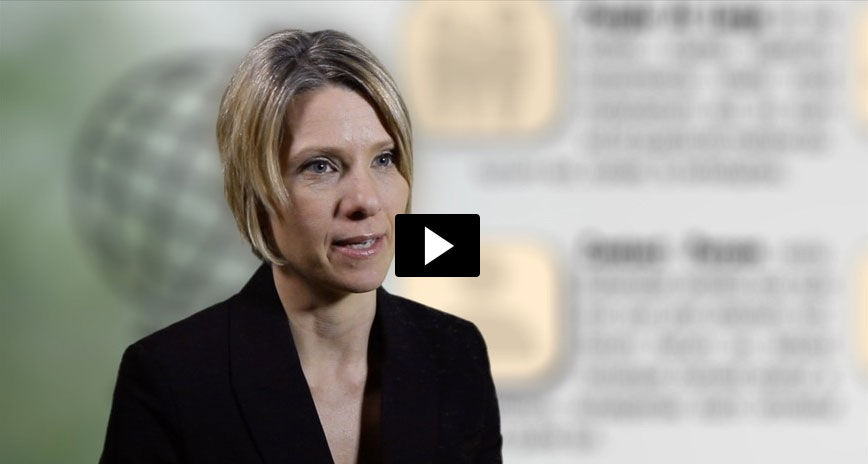
A learning outcome is a “statement describing what and how a student is expected to learn after exposure to teaching” (Biggs & Tang, 2007, p64). Learning outcomes are derived from course goals. Course goals are teacher-centered and provide the instructor with an overarching guideline and framework for instructional design. But it is necessary to go beyond course goals to be explicit and specific about what course goals mean in terms of students’ performance – what do we really expect students to able to accomplish under certain contexts so that we can conclude that course goals have been reached?
Let’s take a look at the following conventional course goals:
- To provide a basic understanding of the elements of nonfiction English.
- To familiarize students with knowledge of standard English grammar.
Imagine if you were an instructor who was given a course to teach with these course goals. How would you interpret these goals in your course design? Would you have a clear picture of what steps you would need to take to help your students to reach your expectations? Would you have ideas on how you would measure students’ achievements? If this were a multi-session course and you were only teaching one session, would you be confident that you were having similar expectations for your students as other instructors?
Now think from students’ perspective: if you were a student reading these course goals, would you be clear on what the instructor expected from you? Would you know how to demonstrate the level of “understanding” and “familiarization” required? Different individuals might have very different answers to these questions based on their expertise, experience, and perceptions.
Course learning outcomes are the clarification/elaboration on course goals about what a student should be able to accomplish as a result of taking the course. They set concrete targets for students to achieve and instructors to teach. They provide directions to instructors on what course materials to include, what teaching strategies and activities will be most helpful for student learning, and how students should be assessed. They motivate student engagement by helping students see the relevance of the course materials and their coursework. They direct student’s attention and efforts to the core knowledge, skills, and attitude of course to reduce student’s cognitive load to facilitate the integration of the new information with student’s prior knowledge.
How do I write learning outcome statements?
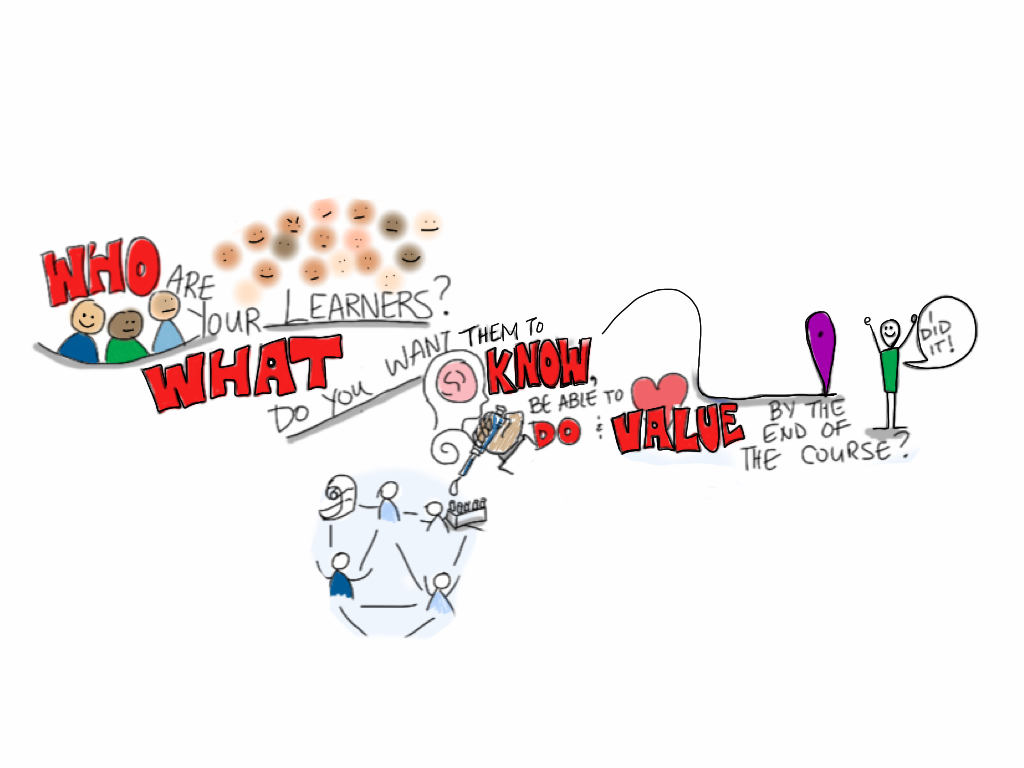
To translate your course goals into learning outcomes statements, you need to consider the following questions:
- What are the most essential things (knowledge, skills, and/or values) my students need to know/learn by the end of this course?
- What level(s) of competency do I expect my students’ to achieve in their learning?
- What should students be able to do to demonstrate their level of learning?
A succinct learning outcome specifies
- What specific tasks students are expected to be able to perform
- The specific level of competence expected for each task
To have learning outcomes that can effectively communicate expectations for student learning, learning outcome statements need to be SMART:
- Student-centred – specify what learners should be able to do after the learning experience
- Measurable – should es the intended learning in a form that can be observed and assessed: use active language/verbs that both describes what learners will do and reflects the level of competency required
- Applicable – should emphasize on how the Knowledge, Skill, and/or Attitude (KSA) acquired can be applied by the learner (results of the learning) rather than the learning process (content)
- Relevant – should be relevant to the course content, student competency, and instructional resources (e.g. course content, length of course) and reflect on the course’s contribution to the program outcomes
- Timely – should be realistically achievable within and appropriate for the length of the class
Samples of effective learning outcomes:
By the end of this course, students should be able to
- Distinguish between Bloom’s domains of learning.
- Construct course level learning outcomes using Bloom’s taxonomy.
- Assess course learning outcomes against degree level expectations.
- Develop methods to evaluate student achievement of learning outcomes.
(Carleton University Teaching and Learning Services, p.2),
Five Steps to write learning outcomes
There are five steps involved in transforming your course goals into learning outcomes as depicted in the image 3.2 below. A worksheet (Appendix A) has also been developed to help you through this process. This section describes each step in detail. To take the full advantage of the five steps and the worksheet, you will need to have a set of predetermined course goals and course content ready.
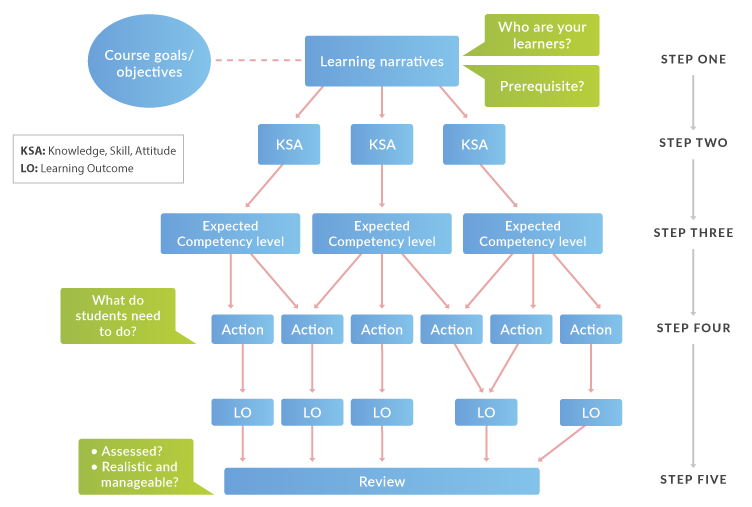
Use your worksheet, found in Appendix A, to draft your course learning outcomes following the steps below:
Step 1: Top text box in the worksheet: Reflecting on your course goals, write a brief narrative that describes a successful learner on your course. Consider these guiding questions: What will the learners know about and know how to do?; Will they think or view the world differently? As you do this keep in mind your current or future students, their prior knowledge, class size, whether they are taking your course as a required course/elective course, etc.
Step 2: Column one of the worksheet: Based on the brief narrative you just wrote in column one, consider: What are the essential Knowledge, Skills, and Attitudes (KSA) that your students need to acquire in order to succeed in this course? KSAs are overarching or broad content categories that a course aims to addresses rather than a detailed list of topics usually included in a course syllabus – we are identifying the basic building blocks of the course, not detailing the components and structure of each building block. For example, in a first year introductory physics course, the course goal is to introduce students to fundamental concepts in classical Mechanics, Wave, and Thermal physics. To specify the essential KSAs, the course instructor decides that to successfully complete this course, students need to have basic understanding in Newton’s three laws, elementary treatment of rigid body and fluid mechanics, thermal phenomena, and the use of statistical concepts in describing the gaseous state. As such, these four overarching content categories are identified as essential KSAs of this course . There is no need to list all/major components and subcomponents (i.e., topic and subtopics that will be covered in individual lessons) of each KSA item.
Step 3: Column two of the worksheet: Specify the level of competency that you expect your students to achieve for each KSA item listed in step two. A useful tool to specify the expected level of competency is Bloom’s Taxonomy. Bloom’s Taxonomy divides learning into three domains: Cognitive (Knowledge) , Psychomotor (Skill), and Affective (Attitude). In each domain, there are various levels of learning with the assumption that the achievement of higher level learning is based on the initial achievement of lower level learning. For example, evaluating or analyzing often depends on students first being able to remember or understand a particular concept.
Review Bloom’s Taxonomy below, and for each KSA item you listed in Column one, consider what level of competency you would expect or want your students to achieve at the end of the course. Should students be able to remember factual knowledge, or should they to be able to apply, evaluate, or create? Record your expectations using the Bloom Taxonomy in spaces provided in Column 2.
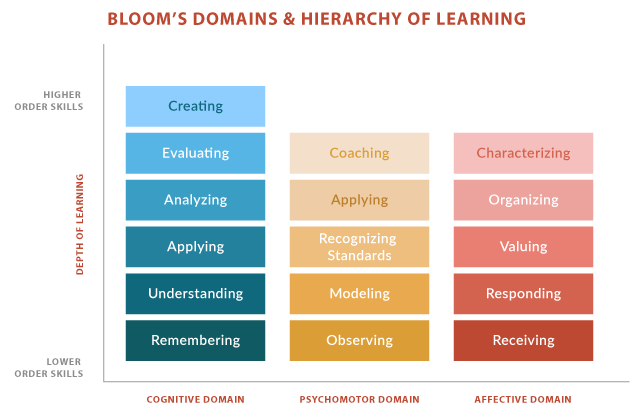
Step 4: Column three of the worksheet: Write your learning outcome statements by specifying the actions students should be able to take to evidence their level of competency. The key to writing a good learning outcome rests with using the appropriate action verb that specifies student performances and corresponds to the level of competency expected from the instructor. Remember, the action verbs should:
- Describe the final product of student learning instead of listing the processes/steps of learning. Keep in mind that the learning outcomes state the learning that results (various ways for students to show success) from the course rather than describing activities or lessons in the course.
- Clearly define the desired students performances that are observable and measurable.
- Should not be vague. Avoid verbs that could subject to multiple interpretations such as “demonstrate the understanding”, “know”, “learn”, and “appreciate”. It is also very helpful to refer to the suggested action verbs for different levels of learning in individual learning domains of the Bloom’s taxonomy. The tip is to think about your major assessment tasks for course learning outcomes.
Action Verbs for Cognitive Domain Learning Outcomes
| Level Name | Level Definition | ACTION WORDS |
| Creating | combine elements to develop new models/ideas | assemble, build, create, construct, design, develop, formulate, generate, hypothesize, invent, modify |
| Evaluating | assess effectiveness, coherence, rationale and make strategic judgments | appraise, assess, choose, compare, conclude, critique, defend, explain, justify, review, recommend, support |
| Analyzing | identify assumptions, key components, & internal relationships; infer main principles; structure information | break down, catalogue, compare, contrast, correlate, deconstruct, differentiate, dissect, extrapolate, infer, investigate, outline, separate |
| Applying | apply or relate information to new contexts | calculate, change, construct, compute, demonstrate, discover, execute, extrapolate, implement, manipulate, predict, show, relate |
| Understanding | know meaning of, and interpret or translate, information | critique, convert, describe, discuss, estimate, explain, formulate, interpret, infer, illustrate, justify, paraphrase, represent, summarize, translate |
| Remembering | recognize or recall facts, details, and information | define, identify, label, list, match, recall, recite, recognize, state |
Action Verbs for Psychomotor Domain Learning Outcomes
| Level Name | Level Definition | ACTION WORDS |
| Coaching | Provide instructions to others to perform task | assess, assist, correct, demonstrate, illustrate, instruct, manage, specify |
| Applying | Apply criteria with no instruction to perform task and evaluate performance in new contexts | adapt, assess, build, calibrate, coordinate, design, infer, manipulate, modify, produce, solve, test |
| Developing standards | Identify criteria for optimal task performance | compose, distinguish, formulate, integrate, judge, perceive, select, synthesize |
| Modeling | Reproduce task based on instruction or memory | copy, display, follow, execute, mimic, recreate, reenact, repeat, reproduce |
| Observing | Use sensory cues to guide or define appropriate action | adhere, choose, copy, detect, follow, identify, observe, relate, replicate, repeat |
Action Verbs for Affective Domain Learning Outcomes
| Level Name | Level Definition | ACTION WORDS |
| Characterizing | Integrates and behaves in line with values in new contexts | act, display, embody, habituate, influence, plan, practice, propose, represent, solve, validate, verify |
| Organizing | Prioritizes values and resolves internal/personal conflict | alter, adjust, arrange, compare, develop, generalize, integrate, modify, order, reconcile, rank, revise |
| Valuing | Displays attachment, involvement, or commitment in class context/assignments | adapt, argue, balance, challenge, critique, confront, differentiate, defend, influence, initiate, invite, justify, persuade, seek |
| Responding | Change behavior to reflect attitude; actively react to or participate in new attitude | answer, behave, clarify, comply, cooperate, discuss, examine, explain, model, practice, present, recite, report, show, summarize |
| Receiving | Become aware of attitude and open to potential value | acknowledge, accept, ask, attend, describe, observe, read, recognize |
(Carleton University Teaching and Learning Services, p.2-4),
Step 5: Review each learning outcome statement that you’ve written in column three and consider:
- Are these statements describing results of students learning that will be assessed? Learning outcome statements describe the expected competency in core knowledge, skills, and attitudes that are essential to the successful completion of the course. For each learning outcome, there must be appropriate assessment tasks in place to verify students’ performance. If there is no plan to assess a particular learning outcome or if the assessment is not appropriate for a learning outcome, you will need to revisit the learning outcome statement in question to consider whether it should be included as an essential requirement of the course or if it should be revised to reflect the actual expectation as indicated by the assessment. You might even come to the conclusion that the assessment is not on a par with the expectations you have for your students and their learning and will therefore need to be revised.
- Are these learning outcomes realistic and manageable for my students? Learning outcomes must be realistic — they establish standards for the course. Consider who your students are? How might their prior experience/skills be relevant to your course? Will there be any prerequisites to this course? Are these learning outcomes too ambitious or too easy for my students? Does my course allow sufficient time for my students to reach these learning outcomes?
You also want to pay attention to how many course learning outcomes you’ve drafted. Having too many or too few learning outcomes is an indicator that your course learning outcomes might not be realistic or manageable for your students. For a 3-credit course (one semester), you will want to have 4-6 (maximum 9) course learning outcomes. If you have more than 9 learning outcomes, first consider whether you can group some of your learning outcomes together (remember course learning outcomes address the results not the process, identify the overarching competency not the detailed topics). If the grouping is not successful, consider prioritizing your learning outcome statements. It is most likely that the drafted learning outcomes at the bottom of your priority list can either be subsumed into other high priority learning outcomes or be more appropriately used as outcomes for individual units or lessons.
Share your learning outcomes with students
For instructors, formulating course learning outcomes provides insights and reflection to the course content and course design. It is also critical to share and even discuss the course learning outcomes with your students at the start of the course.
Course structure: organization and sequencing

Now that we’ve drafted our course learning outcomes, we need to map out how and in what order we will help our students to accomplish the learning outcomes. One important task is that we need to select, organize, and sequence the major contents of the course to structure and organize each course unit (typically a section of the course run each week that covers a particular topic or theme). In this section, we will introduce an easy-to-follow exercise to help you structure and sequence the major content areas of the course. In particular, we will help you to adopt an outcome-centered approach to to determine your course structure and create a course schedule.
Content-Centred Approach
When it comes to planning what we want to teach in a course and in what order we shall teach them, intuitively, many of us take a so-called content-centered approach. It is probably the most widely used approach for content organization and sequencing, particularly for new instructors.
The content-centered approach involves either listing or following the table of contents of main or required textbooks or creating a list of topics based on the instructor’s understanding of the subject matter. The advantage of this approach is that it can be a very easy and fast process. However, this approach focuses on organizing and transmitting information but pays insufficient attention on how students would learn or come to understand this information. It also designs the course from the subject-matter experts’ perspective rather than from the learner’s point of view, who may find this content-heavy approach quite overwhelming, confusing, and even boring. As a result of emphasizing course content over the students’ learning experience, this approach tends to support and promote lower level learning related to, for example, remembering or understanding (Fink, 2003).
An Alternative Approach: Outcome-Centered Approach
We all know that motivation is the key to the success of any kind of learning. Michael W. Allen proposed a model to successful elearning using an equation (Allen, M. W., 2003, p. 150):
e = m2ci
(e = the effectiveness of eLearning; m = motivation; c = appropriate content and its presentation; i = interaction)
This formula suggests that motivation has an exponentially greater impact than the content presentation on students success. Students’ motivation is determined and influenced by many factors, which is beyond the scope of this book. However, we do know from the research that the most effective eLearning designs are those that are built on anticipated outcomes, activity-oriented, and that immerse learners in situations requiring them to acquire skill or knowledge in order to solve problems (Jonassen, 1991). In other words, learners need to be put to work on stated tasks that are meaningful, manageable, and active or participatory for the learning experience to be meaningful and memorable.
Thus, one alternative to the content-centered approach is an outcome-centered approach in which course content is considered as a collection of course themes and topics. Each theme/topic is composed of tasks (and even subtasks) specifying the outcomes (behaviours) students will be expected to achieve and corresponding course content that students will need to utilize to accomplish the required tasks . The organization and sequencing of the course content is therefore a means to create a thematic course structure that shows how the course themes and topics are related to the course learning outcomes, how they build on one another, and how they will be organized and sequenced chronologically. This thematic course structure maps out the route along which students will be guided to acquire new ideas/concepts to work on problems or assignments that are progressively more complicated and challenging as the course proceeds, which will eventually lead to the successful achievement of the course learning outcomes. Learning outcomes can also be assessed and achieved formatively on the path towards the final course outcome(s), as students will often need to grasp fundamental or core concepts before applying them to higher order problems or ideas. This theme-based course structure can be depicted as the image 3.5 below:
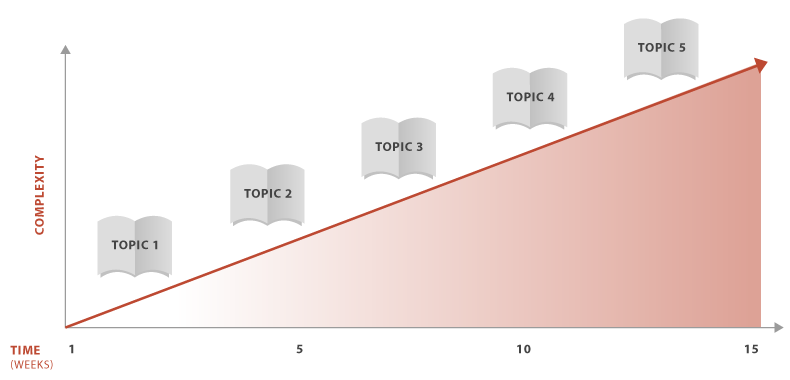
Adopting an outcome-centered approach, the course content can be effectively organized and sequenced by performing a three-step exercise.
- Hierarchy of learning outcomes exercise
- Select and cluster required course content
- Sequencing
The following section is a detailed how-to guide for each step. Kindly note that although the steps are described in a linear fashion, in practice, these steps usually happen simultaneously and are an iterative process.
Step one: Hierarchy of learning outcome exercise
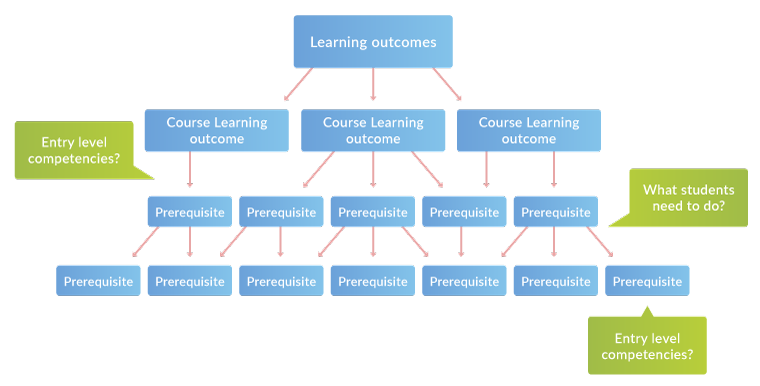
The hierarchy of learning outcomes exercise is the reverse of the exercise of writing course learning outcomes. If formulating course learning outcomes is a bottom-up exercise resembling inductive reasoning, the Hierarchy of learning outcomes exercise is a top-down exercise resembling deductive reasoning. In this exercise, you will break down your course level learning outcomes to a cascade of prerequisite subtasks to determine the components of students’ learning and their interrelationships so the students’ learning journey can be mapped accordingly. The results of this exercise will also help to determine the selection and organization of your course content. This detailed analysis might also lead to revisions of existing course learning outcomes if you find you have too many/few subtasks or they are too ambitious/modest for your students. There are three steps to this exercise:
Step 1: Identify first-level prerequisites: For each course learning outcome,ask yourself “What must a learner be able to do in order to learn this new element?” (Gagne, 1985). The answer to this question can then are stated in the form of learning outcomes (as described above) to become the first-level prerequisite subtasks (subordinate learning outcomes) to the course learning outcomes. This is how you decide how many themes (major waypoints for the achievement of course learning outcomes) that you would have in your course.
Step 2: Identify second-level prerequisite subtasks and subsequent level prerequisites. Take each first-level prerequisite task identified in step 2 and answer the same question“What must a learner be able to do in order to learn this new element?” Repeat this process to identify subsequent level prerequisites until the bottom level prerequisites matching students’ entry level competencies/knowledge, i.e., what the learners currently are able to do, in relation to the final learning outcomes (Horton, 2012,p. 34). You will know you have made it to this stage when:
- You cannot think of any prerequisite that learners do not already possess.
- Students can be referred to resources for revision and remediation
- Prerequisite knowledge/skill are handled by the stated course prerequisites.
See image 3.7 as an example:
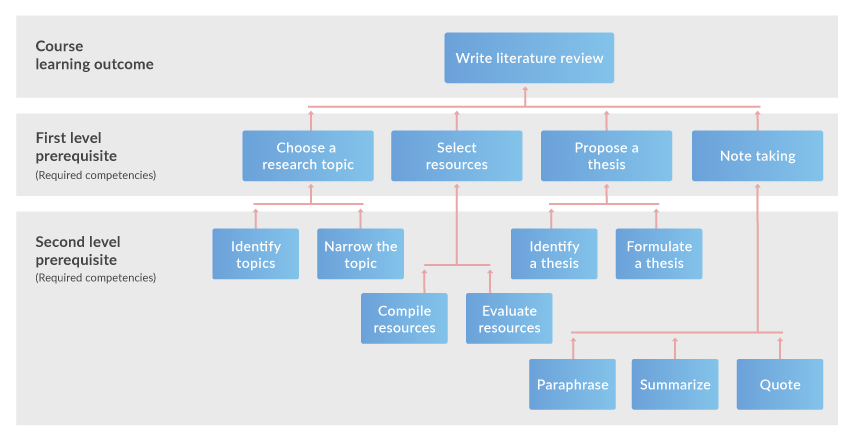
Step 3: Verify the learning hierarchy. Sometimes, step two results in a complicated and extensive map with an overwhelming number of subtasks that your students won’t have enough time to learn in your course. This is sometimes due to an inadequate consideration of the students’ prior knowledge that in turn leads to the analysis of the outcomes in unnecessary detail. Sometimes the opposite happens. You do not want to teach students what they already know. On the other hand, you do not want to miss any key subtasks either. Whether you have overwhelming subtasks or not, it is critical to review the hierarchy to confirm if it contains all the necessary subtasks and does not contain nonessential subtasks. To do this, for each subtask in the hierarchy you ask two questions:
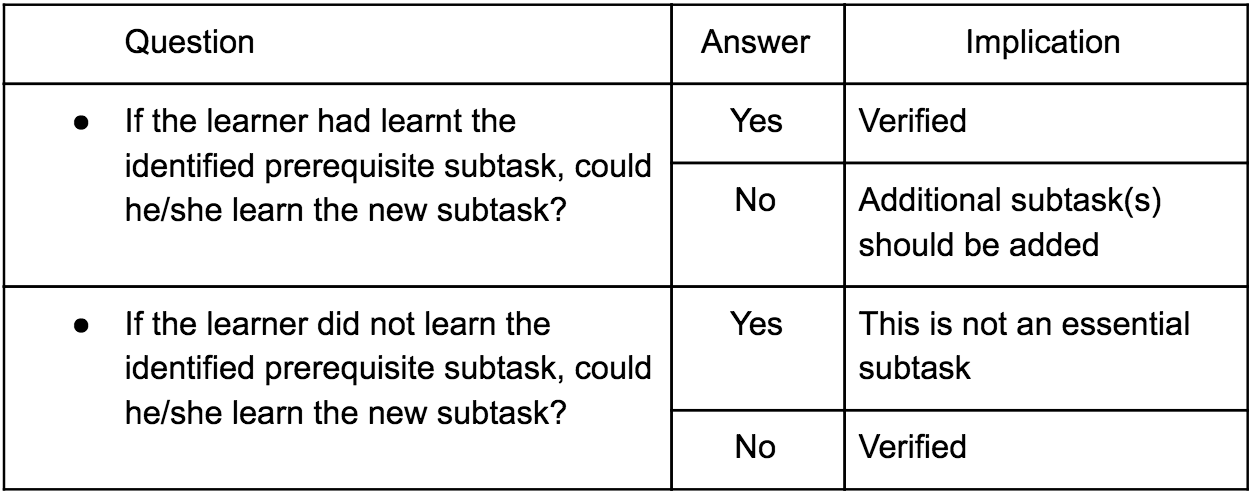
If you still have overwhelming subtasks for your course after the review, you will need to:
- prioritize the subtasks to select which subtasks are most important
- prioritize the subtasks to select which subtasks are difficult for learners
- prioritize the subtasks to select which subtasks are frequently utilized by learners
You can find examples of learning hierarchies @ http://cehdclass.gmu.edu/ndabbagh/Resources/IDKB/more_hierarch.htm. Please keep in mind that the kind of analysis you will do for your course might be more complicated and will look more like a concept map rather than the simpler flow charts in the examples. However, the underlying principles and processes as described in this section remain the same.
Step two: Select and cluster required course content
By completing the learning hierarchy, you have sketched a map of your student’s learning journey. Not only have you determined the start and end points of the journey, the major waypoints along the way have also been identified and mapped out. These major waypoints will determine what content and/or other resources you will need to provide to enable students to perform the tasks required. When deciding on required course content, the general rule of thumb is less is more. The information you provide is only a tool; the key should be on what is essential to enable student’s performance. You want to require only content (e.g. readings) that are core to student’s learning, as Students can always look up additional information themselves.When finalizing your list of course content, consider the following:
- You do not want to teach students what they already know. Consider omitting content for stated course prerequisites and put them in reference and resources.
- Think carefully about the value of all “nice to know” or “nice to have” content. Move them to reference and resources, rather than listing them as required readings, if you want to include them.
- Check for redundancy. Keep the key content and move the redundant ones to references and resources.
Once you have worked through the learning hierarchy to select your course content, now it’s time to cluster the learning components (subtasks and their corresponding content) you’ve identified based on their relationship with the course learning outcomes and one another. You can now draft a course structure flow chart to indicate how many units you will have, whether and how many sections you will have in each unit, and what your students should be able to achieve in each unit/session. Take a look at the course map shared through this link http://blogs.agu.org/geoedtrek/files/2014/07/ECON201OnlineVisualSyllabus-copy1.png as an example.
Step three: Sequencing
The course map you created using the previous steps has laid a solid foundation for selecting sequencing strategies to provide a manageable and well-structured flow to your course. In most cases, the identified learning components and their interrelationship largely influence the order you should teach your content and how much flexibility your students can have moving through the waypoints of their learning journey. In step three, we introduce three sequencing strategies you can choose to adopt or mix based on your course map, the nature of the subject, your teaching style, and what your students might be comfortable with.
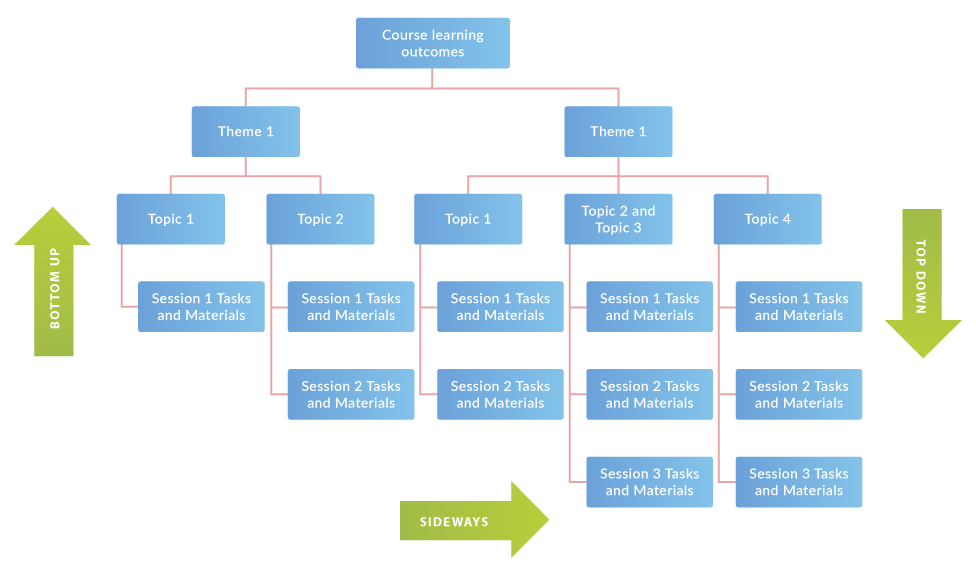
The most commonly used sequencing strategy is the bottom up sequence. In a bottom up sequence, teaching begins with the lowest level prerequisites and proceeds upward. A bottom up sequence is similar to how to we conventionally teach — starting from the simple concepts and moving towards more complicated materials. It is most effective and appropriate for learning outcomes that require a linear, sequential, and structured instruction and for students who may be novices or lack foundational knowledge of a field.
In a top down sequence, students begin their learning with the highest level outcomes. The top down sequence provides a more flexible and less linear teaching and learning environment where students can choose their learning path by continuing down the hierarchy to study the prerequisites they may not have yet mastered. The top down sequence has the advantage of efficiency as learners only study the prerequisites that they need. This strategy is a good fit for students who already have a strong understanding of the topic and who want to identify and address the gaps in their current knowledge and skills.
In a sideways sequence, students have the opportunity to to take a self-directed path to learning. They can move back and forth between the course topics freely to discover and satisfy prerequisites as encountered. The sideways sequence is most suitable for courses or units where you want your students to learn on their own by navigating a complex and dynamic situation, such as discovery learning and problem-based learning.
These three strategies are all good and valid options for sequencing your course activities and outcomes.. However, for overall course structure in higher education, bottom up sequencing is most frequently used; side sequencing and top down sequencing is usually applied in structuring individual course units. If we consider the design of a 12-17 week course, near the beginning of the course you will want to design experiences that lay the groundwork for more complex thinking and activity, and your mid course experiences should begin assessing the degree to which course outcomes have been achieved. In the final few weeks of the course your learners will be experiencing more complex assessments of their cognition and performance based on what has already been explored, not that which is new.
It is not unusual that you will find yourself using more than one sequencing strategy to organize your course unit. For example, you may use a bottom up sequence to introduce new material and a sideways sequence to promote critical thinking and effective problem solving once students have satisfied their initial prerequisites. Structuring and sequencing your activities and assessments as guideposts in supporting your student’s’ achievement of learning outcomes should not be viewed as simply laying a cookie cutter over your course content. There should be overall alignment of the major components of your course design but sequencing isn’t always straightforward or linear. earning can start and/or end with assessment and can also start or end with observation or practice.
There is a lot of room for creative and engaging instructional experiences within a structured and thoughtful course design. Think back to those times when you were truly engaged as a learner. You may have been asked by your instructor to observe an environment or situation (real or hypothetical) and perhaps determine potential refinements that would improve a performance or experience, and then you may have been required to execute your plan so that you could observe and test the results. Communicating what you learned from that experience was a great way for your instructor to assess the results of your investment in that one learning cycle, and that single unit or activity helped to prepare you for deeper learning and more complex tasks later in the course (or demonstrated achievement of the course’s final, most complex learning outcomes).. All cycles should lead learners toward more complex and more challenging activities and assessment. You will, of course, have many learning cycles in your courses and therefore many opportunities for your learners to interact with you, the curriculum, and each other.
Create your Course Schedule
Once you have completed the three steps for creating a course structure, you are ready to create a detailed schedule for your course. There are a few important considerations that you will need to take into account to refine your course structure to fit into a typical 12-week or 14-week schedule.
Student Workload Expectations
The course structure details the components of students learning (units of instruction) and how these components will be organized and sequenced based on the instructor’s understanding of the course learning outcomes, the subject matter, and their students. In practice, student workload and pacing are two factors that might have significant impact on whether the course structure can be realized into a workable course schedule.
Each component of the course structure has student workload implications.To cluster and organize the course structure components into a course schedule requires not only an understanding of the interrelationship of the individual components and how they relate to the course learning outcomes, but also requires an estimation of, on average, how long it might take a student to accomplish each individual component and an understanding of what would be a reasonable expectation for student workload.
How long can we reasonably expect students to study for a 3-credit hour undergraduate course on a weekly basis? Unfortunately, there is no clear cut answer to this question. Different institutions, disciplines, academic units, and instructors might have different expectations. We would recommend to check whether your institution and academic units have guidelines on student workload. If no guideline is available, consult with your colleagues and draw from your previous teaching experience. If all else fails, a rule of thumb is that a 3-credit hour undergraduate course translates into 2-3 hours of student work for each in-class hour. If you have 12 weeks of instruction, for example, a 3-credit hour course equals to roughly 100 hours of study. If you find that this estimation does not reflect your expectations or experience, you may want to review the following guidelines from several different universities to see whether any of them might better fit your situation. You will notice, however, that most of the guidelines discuss student workload in the context of face to face instruction – ideally, the student workload in an online course should be equivalent.
- Credit System — McGill University
- University of Minnesota’s Expected Student Academic Work per Credit
- Carnegie Unit Definition of Credit hour
- What is a Unit — Stanford University
- Student Workload Guidelines — University of Iowa
- Credit hour and Student Workload Policies — University of Oregon
How long will it take students to finish coursework?
Once you’ve decided how long you can reasonably expect your students to study for your course, you will also need to have a general estimation of how long it will take your students to finish each component of your course. This estimation is not often an easy task. There is very limited understanding and research on how long it takes students to complete their coursework, and as instructors who are subject matter experts we may sometimes forget that concepts, skills, and tasks that are easy for us could be new and difficult for students. It is advisable, then, to consider that students often need significantly more time than we thought necessary to do their coursework. But how much more time might they need? A commonly accepted suggestion is that it is reasonable to expect that your students have to take 3 times longer than you would need to accomplish the same task. If you find this suggestion too general, you can also use the course estimator developed by Rice University for a more detailed estimation http://cte.rice.edu/blogarchive/2016/07/11/workload.
The online learning environment is an important, additional factor to consider when planning your course timeline. Everything takes longer online, including accessing and downloading course content. Allowing sufficient time-on-task is crucial for students success when learning online. Students might need additional time to learn how to use the technical tools required for their coursework. Compared to having a face-to-face conversation, it will also take students extra time to go through online postings to engage in a dialogue with their peers. Online collaborations take significantly more time than working in face-to-face groups. Students may be able to make their first decision on their group project in a couple of hours in a face to face session. In an online environment, however, you may need to allow two days for students to discuss back and forth asynchronously for all group members to share their ideas.
If you have done a particular activity in face to face class, you will have some idea of how much time might be needed to complete it. If you are hoping to use the same activity online, you will need to allow students additional time to complete it. If you are not sure about how long it will take for students to complete a particular task or activity, you might want to ask a student or your Teaching Assistant (or even yourself) to try out a discrete portion of it and time them. You may, however, consider allowing students even more time than you and your TA estimate they will need.
Chapter Summary
Learning outcomes are valuable, essential guideposts for organizing your course syllabus. Well-written outcomes offer students important insight into the knowledge, skills, and attitudes (KSAs) that they can expect, and will be expected to, demonstrate as part of a successful learning experience. Your outcomes, however, can only be meaningful waypoints if they are accompanied by a well-developed structure and process. How and when will your students acquire the essential, foundational skills that will allow them to move toward higher level and more complex outcomes? How much time might it take for your students to complete each unit of course content? A course schedule is much more than filling a required number of hours on a syllabus. Consider how you will sequence your course content and structure your learning activities to build on students’ prior knowledge, engage them in learning new content, and prepare them for success outside of and beyond the classroom.
Reflective Questions and Tasks
- Use the worksheet provided in Appendix A, formulate/revise a set of course learning outcomes to have SMART learning outcomes for a course of your choice.
- Take the Outcome-Centered Approach introduced in this chapter to review/decide the structure of a course you are teaching/about to teach.
Appendix A
References
Allen, M. W. (2003). Michael Allen’s guide to eLearning. San Francisco, CA: Wiley and Sons.
Carleton University Teaching and Learning Services. (n.d.). How to define and write learning outcomes, Retrieved from: http://carleton.ca/cuopen/wp-content/uploads/Module-5-How-To-Define-and-Write-Learning-Outcomes.docx
Fink, L. D. (2003). Creating significant learning experiences: An integrated approach to design college courses. San Francisco, CA: Jossey-Bass.
Gagne, R. (1985). The conditions of learning, 4th ed. New York, NY: Holt, Reinhart, and Winston.
Horton, W. (2012). E-Learning by design (2nd ed.). San Francisco, CA: Wiley and Sons.
Jonassen, D. H. (1991). Thinking technology: Context is everything. Educational Technology, 31(6), 35-37.
Jonassen, D. H., Tessmer, M., & Hannum, W. (1998). Task Analysis Methods for Instructional Design. Mahwah, NJ: Routledge.

